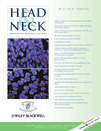Viable tumor in postchemoradiation neck dissection specimens as an indicator of poor outcome
Abstract
Background
The objective of this study was to determine the prognostic significance of viable tumor in postchemoradiation neck dissection specimens in patients with squamous cell carcinoma of the laryngopharynx.
Methods
Retrospective analysis identified 181 patients treated with primary concurrent chemoradiation for carcinoma of the laryngopharynx at Memorial Sloan-Kettering Cancer Center between the years 1995 and 2005. Of these, 56 patients had a comprehensive neck dissection either as a planned or salvage procedure. Neck dissection specimens were analyzed by a single pathologist for the presence of viable tumor. The presence of viable tumor was correlated to the timing of neck dissection after chemoradiation and to tumor response. Overall survival (OS), disease-specific survival (DSS), and recurrence-free survival (RFS) were determined by the Kaplan–Meier method, and correlation to tumor viability was determined with the log-rank test.
Results
Nineteen (33%) patients had viable tumor in their neck dissection specimens. Viable tumor was higher in patients who had a less-than-complete response to chemoradiation compared with those who had a complete response (42% vs 25%, p = .1). There was no correlation to timing of neck dissection. The 5-year OS, DSS, and RFS were significantly lower in patients who had viable tumor in their neck dissection specimens (OS 49% vs 93%, p = .0005; DSS 56% versus 93%, p = .003; RFS 40% vs 75%, p = .004).
Conclusions
Patients with viable tumor in postchemoradiation neck dissection specimens had a poorer outcome compared with patients with no viable tumor. © 2010 Wiley Periodicals, Inc. Head Neck, 2010




